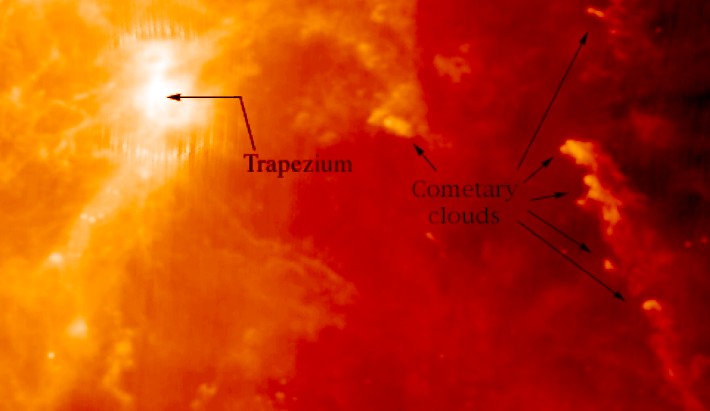Explanation: Intense ultraviolet light from massive, hot stars in the Orion region has sculpted and compressed clouds of dust and gas in to distinctively shaped Cometary Globules. Seen in this IRAS infrared image recorded at a wavelength sensitive to emission from dust, the elongated globules are easily visible along with a bright region which corresponds to the Trapezium star cluster. Otherwise known as the Witch Head Nebula, IC 2118 is the string of globules near the middle right. Suggestively similar to comets in general appearance only, Cometary Globules are interstellar condensations on a vastly different scale. These are likely related to star formation episodes in the Orion molecular cloud. Besides those indicated by the arrows, more comet-shaped clouds or globules are present in this image.
1999 2000 2001 2002 2003 2004 2005 2006 2007 2008 2009 2010 2011 2012 2013 2014 2015 2016 2017 2018 2019 2020 2021 2022 2023 2024 2025 |
Yanvar' Fevral' Mart Aprel' Mai Iyun' Iyul' Avgust Sentyabr' Oktyabr' Noyabr' Dekabr' |
NASA Web Site Statements, Warnings, and Disclaimers
NASA Official: Jay Norris. Specific rights apply.
A service of: LHEA at NASA / GSFC
& Michigan Tech. U.
|
Publikacii s klyuchevymi slovami:
nebula - dust - Orion - star formation - Molekulyarnye oblaka - globuly - Oblasti zvezdoobrazovaniya
Publikacii so slovami: nebula - dust - Orion - star formation - Molekulyarnye oblaka - globuly - Oblasti zvezdoobrazovaniya | |
Sm. takzhe:
Vse publikacii na tu zhe temu >> | |
